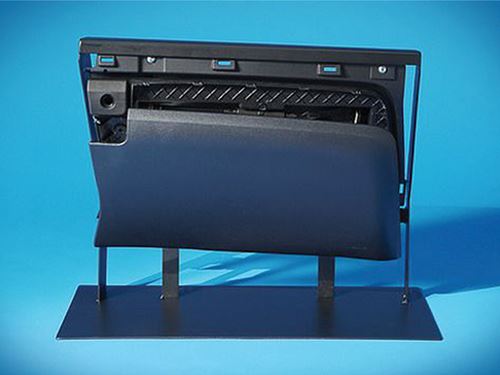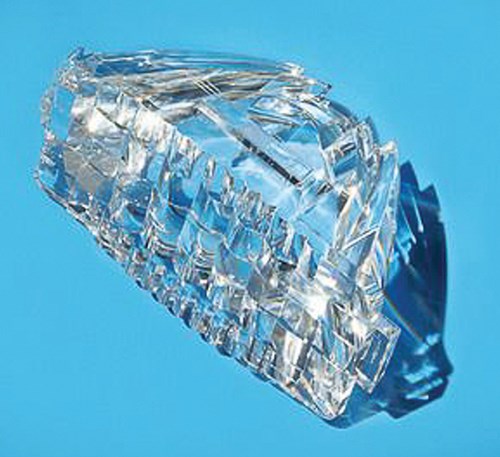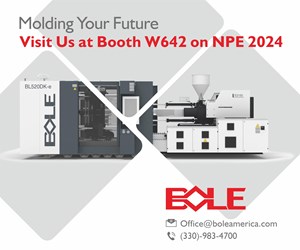Numerous ‘Firsts’ Among Winners of 2014 SPE Automotive Innovation Awards
CLOSE-UP: AUTOMOTIVE
The 44th annual awards competition broke new ground in almost all award categories
November’s announcement of the winners of the 44th-annual Automotive Innovation Awards Competition, sponsored by the SPE Automotive Div., presented industry “firsts” in almost every category. The awards recognized achievements in parts consolidation, surface finish, use of high-strength thermoplastic composites, renewably sourced raw materials, and processing advances.
INTEGRATED GLOVE-BOX DOOR & AIRBAG
The Grand Award winner and winner of the Safety category was an injection molded “active glove box” and integrated knee airbag system on the 2015 Ford Mustang. It is produced by Faurecia Interior Systems, Auburn Hills, Mich., using engineered PP compounds from Mitsubishi Chemical Performance Polymers, Inc., Greer, S.C. Extol, Inc., Zeeland, Mich. produced the hot-plate weld tooling for the part.
This patented application is reportedly an industry first whereby an injection molded knee airbag is integrated with the glove-box door. The result is a 65% reduction in weight and 75% in space versus a separate knee airbag and glove-box door, plus a savings of $5 to $10/car. In place of a woven textile airbag, a special bladder is hot-plate welded to the door and checked with a hydrostatic burst tester to ensure the strength of the resulting hermetic seal.
Materials used include two materials from Advanced Composites, Sidney, Ohio: ADX 5028, a 20% talc-filled PP with high rubber content for cold ductility; and ADX 5017, a 20% talc-filled PP stiffer than 5028 to provide a reaction surface; as well as Misubishi's TT850N, a TPO developed for airbag doors that performs well at high-strain rates in hot and cold temperatures. This integrated design is now standard on the mass-produced 2015 LHD Mustang and on 2016 Europe LHD and RHD Mustang.
NYLON/LONG CARBON FIBER SUNROOF FRAME
The 2015 Kia Sorento crossover utility vehicle from Hyundai Motor Group features a very large but very light injection molded panoramic sunroof frame. The winner in the Body Exterior category, it uses 20% long carbon fiber (LCF) reinforced nylon 6 from Korea’s GS Caltex Corp., which was optimized for density, mechanical properties, and cost. It also will be standard on other new Hyndai and Kia vehicle models.
It is said to be the first carbon-fiber-reinforced thermoplastic in a sunroof frame, replacing glass fiber for weight reduction and stiffness improvement. Manufactured by Korea’s Inalfa Roof Systems and tooled by Hyundai, it allowed 33 steel parts to be integrated into just four plastic ones. Instead of a conventional compounding process, a long-fiber pelletizing process was utilized to maximize performance. Localized steel reinforcement boosts performance while optimizing geometry, weight, and cost.
Compared with the short-glass reinforced PBT/ASA alloy previously used for the frame, Caltex’s Hiprene ALC12B nylon 6-LCF 20 boasts superior mechanical properties, including tensile, flexural, and impact strength, plus improved dimensional stability, and is 20% lighter (15.7 lb). It was cost-neutral vs. the previous technology despite the use of expensive carbon fiber.
PP COMPOSITE SECOND-ROW SEAT BACK
The 2015 Ford Mustang features the first Ford composite seat back. The winner in the Body Interior category is the second-row seat back which meets very challenging safety regulations—ECE luggage-retention load—while achieving lower weight and cost.
Manufactured by Continental Structural Plastics Inc., Auburn Hills, Mich., the compression molded seat back is made from PP homopolymer unidirectional GMT (glass-mat thermoplastic) sheet (45% glass) with no steel reinforcement. It is molded in a two cavities and the material is supplied by Hanwha L&C USA, Opelika, Ala. The one-piece unit replaces a five-part, all-steel design and saves 6.83 lb per car in a thinner construction that also is easier to install.
COEXTRUDED COOLANT TUBE
France’s 2015 Renault Twingo city car won the Chassis & Hardware category with what appears to be a first-of-a-kind coextruded plastic coolant tube with patented bellows design to replace aluminum tubing and rubber hose. The technology is already commercial at another OEM. It delivers a 60% weight reduction and enhanced flexibility and formability.
Germany’s Tristone Flowtech Group (U.S. office in Detroit) produced the part in collaboration with DuPont Performance Polymers, Troy, Mich., which supplied the materials. Zytel LD6200 nylon 612 extrusion grade was used for its chemical resistance and flexibility. To improve its hydrolysis resistance at 125 C (257 F), a thin layer of new Bynel functionalized high-temperature PP provides a moisture barrier. This coextruded construction was shown to withstand 125-135 C (257-275 F) internally and up to 150 C (302 F) externally.
According to DuPont, large-diameter nylon tubing requires bellows to bend, but at high temperatures and pressures, these bellows can creep and open up into what resembles corrugated tubing. This affects tolerances and increases stress in those areas. The design solution in this case is a flat spot where the tube does not bend, providing tensile strength to prevent expansion. These variable-stiffness bellows enhance the flexibility of high-temperature plastic tubing without the negative corrugating side effects.
CELLULOSE FIBER COMPOSITE ARMREST
The 2013 Lincoln MKX featured an injection molded cellulose-composite console armrest. Winner of the Environmental category, this is said to be the first time glass-reinforced PP has been replaced by a natural-fiber reinforced PP. Ford plans future applications of this technology in structural interior and exterior parts, Class A exterior parts, and underhood uses.
The current application is the armrest substrate that carries a load for the center floor console. It is manufactured by Johnson Controls, Inc., Milwaukee, using WNS-M4D1033-A1, a 20% cellulose-reinforced PP homopolymer from Weyerhaeuser NR Company, Federal Way, Wash.
Performance of the part is reportedly on par with the glass-filled PP version. Use of the renewably sourced reinforcement results in a 6% weight reduction, 10% cycle-time reduction, and 40° F temperature reduction. Reduced tool abrasion and equivalent cost are also cited. Ford estimates life-cycle impacts of this construction vs. glass-filled PP at over 2500 gal in fuel savings.
SINGLE-COLLIMATOR, TRIPLE-SHOT LED LENS
The 2015 Ford F-150 pickup truck features an industry-first single-colliminator injection molded LED lens for low- and high-beam LED headlamps. The PC-based lens—winning the Process, Assembly & Enabling Technologies category—is half the weight of the glass lens used previously, which required two parts to achieve the same level of light output now being delivered by a single element. Ford says this efficient LED optical lens allows stylists a new level of freedom in headlamp design and sees this modular and transferable technology becoming an industry standard.
Tier 1 lamp supplier Flex-n-Gate, Urbana, Ill. and its Ventra Plastics subsidiary utilized a multi-shot injection process with special molding presses having three different barrel sizes to produce this 45-mm (1.77-in.) thick, precision optical lens with molded surface tolerances within 40 microns. It is made from PC-LED2245, a special optical-grade PC from Bayer MaterialScience, Pittsburgh. Special tooling, using inserts and diamond-cutting finishes to reproduce perfect optical surfaces without the polishing required by glass, was developed by DBM Reflex, Laval, Que.
MOLDED-IN-COLOR METALLIC FINISH PANELS
The 2015 Ford Mondeo sports the first molded-in-color metallic-appearance parts—console panel, center stack panel and shifter surround bezel—and took home the Materials category award. These parts avoid weld lines around holes using the eMold process to elevate resin temperature in key areas. Replacing metallic paint, this innovation boasts a direct cost savings of $13/car; offers improved appearance and quality; eliminates VOCs and CO2 created by paint lines, as well as paint waste to landfills; and improves worker health safety. Ford sees the application of this technology as “the tip of the iceberg,” estimating future opportunity across entire vehicles growing at a 6 million units/yr.
The eMold process is a hot/cold molding technique that uses electric heating of the core side of the mold followed by rapid cooling, all within 30 sec.
The finish panels are molded by Key Plastics LLC, Northville, Mich., for Germany’s International Automotive Components (U.S. office in Anniston, Ala.). Samsung Chemical North America, Mirada, Calif., developed LX-1098 Luminous PC/ABS, a new high-flow, impact-modified automotive grade with novel metallic colors that are matched to Paint Masters. It boasts excellent UV resistance, scratch and mar resistance, and morphology control that delivers lush, subtle gloss and easy, smooth flow for weld-line reduction. In addition, special gate/runner designs and a special tool-finish technique were used in combination with the eMold processs with continuous venting.
CRANKSHAFT COVER WITH INTEGRATED OIL SEAL
The 2014 Volkswagen AG MDB engine platform features the world’s first “sustainable” crankshaft cover, which won the Powertrain category award. It is injection molded from 40% glass-reinforced EcoPaXX nylon 410, which is 70% derived from renewable resources and is certified as cradle-to-grave 100% carbon neutral by the supplier, DSM Engineering Plastics (U.S., office in Birmingham, Mich.). Replacing thermoplastics like nylon 46 and 66, it boasts 40% lower weight and 25% lower cost than aluminum flanges of similar geometry, and around 2.5% lower weight than nylons 46 and 66.
The design features a friction-optimized, integrated PTFE dynamic seal, which replaced a wet-chemistry surface treatment. It is activated via a proprietary vacuum plasma process patented by Kaco GmbH. The design also enables a plastic flange to act as a torque support for assembly operations during vehicle manufacture. VW says the materials and technology are ready for mass production and that the overall concept allows for very competitive market price.
Related Content
Improving Twin-Screw Compounding of Reinforced Polyolefins
Compounders face a number of processing challenges when incorporating a high loading of low-bulk-density mineral filler into polyolefins. Here are some possible solutions.
Read MoreThe Fundamentals of Polyethylene – Part 2: Density and Molecular Weight
PE properties can be adjusted either by changing the molecular weight or by altering the density. While this increases the possible combinations of properties, it also requires that the specification for the material be precise.
Read MorePolyethylene Fundamentals – Part 4: Failed HDPE Case Study
Injection molders of small fuel tanks learned the hard way that a very small difference in density — 0.6% — could make a large difference in PE stress-crack resistance.
Read MoreFundamentals of Polyethylene – Part 6: PE Performance
Don’t assume you know everything there is to know about PE because it’s been around so long. Here is yet another example of how the performance of PE is influenced by molecular weight and density.
Read MoreRead Next
How Polymer Melts in Single-Screw Extruders
Understanding how polymer melts in a single-screw extruder could help you optimize your screw design to eliminate defect-causing solid polymer fragments.
Read MoreLead the Conversation, Change the Conversation
Coverage of single-use plastics can be both misleading and demoralizing. Here are 10 tips for changing the perception of the plastics industry at your company and in your community.
Read MoreWhy (and What) You Need to Dry
Other than polyolefins, almost every other polymer exhibits some level of polarity and therefore can absorb a certain amount of moisture from the atmosphere. Here’s a look at some of these materials, and what needs to be done to dry them.
Read More













.png;maxWidth=300;quality=90)



















